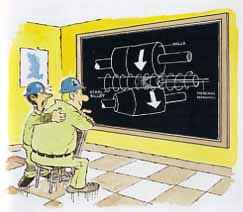


Broadly speaking, all tubular steel products can be divided into two large categories according to how they are manufactured:
1. Welded pipe and tubing
2. Seamless pipe and tubing
Incidentally, the distinction between tubing and pipe is often hazy. Tubing is usually available in many more sizes, is made to a higher level of precision, and is intended for more specialized applications than pipe. Thus, a shock absorber or a hydraulic cylinder is made of steel tubing while many plumbing systems use steel piping.
J&L makes tubular products at Aliquippa, Youngstown and East Chicago, at our specialty tube plants in Oil City, Pennsylvania and Gainesville, Texas, and at the Van Huffel Tube Corporation in Warren, Ohio and Gardner, Massachusetts. We use three different tube-making technologies:
1. Continuous welding-Here, a strip like steel product called skelp is passed through a furnace that heats it to welding temperatures. As the continuous strip of hot skelp emerges from the furnace, a series of rolls bend it into a tube and push the molten edges against each other to weld them together. Finally, a series of sizing rolls squeezes the still-hot tube to proper size and a saw cuts the tube to desired length.
2. Electric welding-First, the skelp's edges are trimmed to make them parallel. Next, a series of forming rolls bends the cold steel into a tube and presses the edges together. Then, the tube rolls under an electrode wheel, a pair of side-by-side copper electrodes, that feeds an intense electric current through the seam. The heat generated by the current flow melts the skelp's edges and welds them together.
3. Seamless tube making-The important thing
to remember about this process is that it does not remove metal
to make a tube. Instead, a heated round billet of steel is pushed
against a pointed mandrel by a pair of rolls (above). As the rolls
rotate, they simultaneously turn the billet and propel it forward.
The mandrel pushes through the hot metal to form a hollow tube
(above). This mandrel serves as a supporting core when the tube
passes between several series of rolls that reduce the tube's
wall thickness and diameter to the desired dimensions.